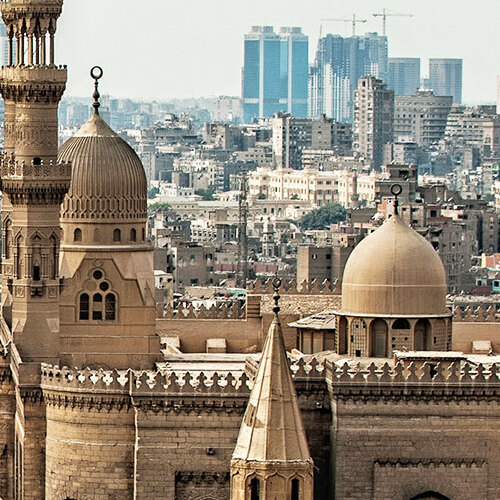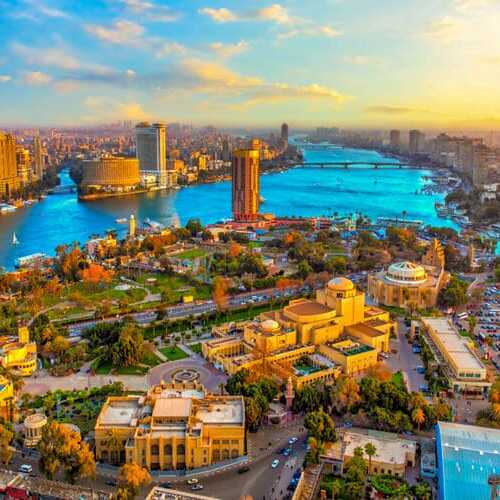History Chronicles
A Traveler's Guide to the City's Past
Cairo, Egypt’s pulsating capital, has long been the fulcrum of historical intrigue and geopolitical importance, thanks to its strategic location near the Nile Delta. While the modern city traces its origins to the first millennium, its story intertwines with the epoch of Ancient Egypt.
In the waning days of the 4th century, as Memphis‘s significance dwindled, the Romans fortified the east bank of the Nile with a stronghold known as Babylon. This bastion, the oldest structure in Cairo today, was central to the Roman and subsequent Byzantine city. It lies at the heart of the Coptic Orthodox community, which emerged following a schism from the Roman and Byzantine churches in the late 4th century. Coptic Cairo, a district within the city, is a mosaic of ancient Coptic churches, including the iconic Hanging Church, nestled along the fortress wall.
The Islamic era dawned with Amr ibn As’s conquest in 640 AD. He established al-Fustat, meaning “City of Tents,” to the north of Babylon. This tented camp evolved into a permanent settlement, becoming the first Islamic capital in Egypt. A shift in power in 750 AD saw the Abbasids replace the Umayyads, leading to the construction of al-Askar, “the city of Cantonments,” northeast of Fustat. Al-Askar, however, was short-lived, giving way to al-Qatta’i, “the Quarters,” built by Ahmad ibn Tulun in 869 AD. This new city, centered around a palace and the Mosque of Ibn Tulun, flourished briefly before the Abbasids reclaimed control and razed al-Qatta’i, returning to Fustat in 905.
The landscape of Cairo was reshaped in 968 when General Jawhar al-Siqilli, under the Fatimid dynasty, founded a fortified city northeast of Fustat. Named al-Qāhiratu, “The Victorious,” by Caliph al-Mu’izz, this city symbolized the Fatimids’ triumph. It also saw the inception of the al-Azhar Mosque, destined to become a revered seat of learning. Over the centuries, Cairo absorbed the earlier settlements of Fustat, al-Askar, and al-Qatta’i, collectively known as “Old Cairo,” and emerged as the enduring capital of Egypt.
Saladin’s ascension in 1169 marked the beginning of the Ayyubid dynasty. He fortified Cairo with the construction of the Citadel, a symbol of government authority until the mid-19th century. However, Cairo’s story was far from over. The Mamluks, slave soldiers turned rulers, transformed Cairo into the heart of their empire in 1250. They initiated construction projects, propelling Cairo into a hub of Islamic scholarship and a key player in Afro-Eurasian trade.
The Black Death ravaged Cairo repeatedly between 1348 and 1517, devastating its population. The city’s prominence waned further when Vasco da Gama’s discovery in 1497 rerouted the spice trade, bypassing Cairo. Ottoman conquest in 1517 relegated Cairo to a provincial capital, though it remained economically and culturally significant. The city’s skyline was dotted with high-rise apartment buildings in the 16th century, a precursor to modern urbanization.
Under Ottoman rule, Cairo expanded south and west, becoming the empire’s second-largest city. However, by the time of Napoleon’s arrival in 1798, Cairo’s population had dramatically declined. The French occupation was brief, and in 1805, Muhammad Ali Pasha’s rise marked the dawn of modern Egypt. His grandson, Isma’il Pasha, envisioned transforming Cairo into a Parisian-style city. Despite financial constraints, parts of this vision materialized in what is now Downtown Cairo.
Cairo’s landscape shifted in the 20th century, with independence in 1922 followed by rapid urban expansion. The city continued to thrive, with President Nasser’s developments in the 1950s and 1960s further shaping its modern form. The city was not immune to disaster, suffering significant damage in the 1992 earthquake.
The 21st century brought new challenges and changes. The 2011 Egyptian Revolution, centered in Tahrir Square, was a pivotal moment, leading to the resignation of Hosni Mubarak. In 2015, President el-Sisi announced plans for a new city east of Cairo, intended to become Egypt’s future capital.
Today, Cairo stands as a city steeped in history yet constantly evolving, a blend of ancient traditions and modern dynamism, forever the heart of Egypt.
Created On May 4, 2020
Updated On January 26, 2024
The Complex of Sultan Ashraf Barsbey
Khanqah-Mausoleum of Farag Ibn Barquq
Mosque-Madrassa of Sultan Hassan
Mosque-Madrassa of Umm Sultan Sha’aban
Beit Al-Suhaymi(Al-Suhaymi House)
Khanqah & Mausoleum of Sultan Baybars al-Gashankir
Sabil And Kuttab Of Abdel Rahman Katkhuda
Madrassa And Mausoleum of An-Nasir Mohammed Sultan
Madrassa And Mausoleum of Barquq
Madrassa & Mausoleum of as-Salih Ayyub
Bein al-Qasreen STREET(Between The Two Palaces {Street})
Madrassa & Mausoleum of Qalawun
Midan Al-Hussein(Sayedna Al-Hussein Square)
Khan Al-Khalili Bazaar (Cairo’s Most Famous Bazaar)
The Church of St Sergius & Bacchus



